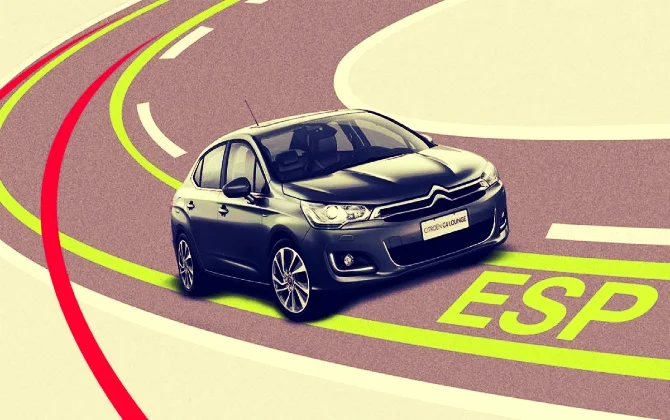ESP or ESC is an intelligent vehicle technology that helps
prevent stabilize your car when it begins to veer off your intended path by
detecting and reducing the loss of traction (skidding).
What is the ESP System in
Cars?
Components of the
Electronic Stability Program
What is Electronic Stability Program and How Does ESP System Work?
What is the ESP System in
Cars?
Electronic Stability Program (ESP®) or Electronic Stability Control (ESC) is an intelligent vehicle safety system that can predict driving intentions, help the driver
maintain wheel trajectory and adjust engine performance in critical maneuvers.
ESP (or ESC system) is considered one of the most important
safety systems in cars to enhance vehicle stability and to keep the car safe in
a way that makes it continuously monitored.
ESP system in cars includes a dedicated dashboard warning
light and comes in the form of a yellow car with two sliding signs under it,
the warning light turns on if the car is in danger.
And if the warning light continues to light, this
indicates that the system is malfunctioning or has malfunctioned, and in both
cases, it is preferred to check it with a specialist.
The ESP system in cars consists of the functions of an
anti-lock braking system (ABS) and a traction control system (TCS), but it can
do much more.
Some car manufacturers market ESP® under different names,
such as Vehicle Stability Control (VSC), Vehicle Stability Assist (VSA),
or Dynamic Stability Control (DSC ). The functions and operation of ESP,
as well as the gains it provides in driving safety, are the same.
ESP and ESC: Is there any difference?
No. In fact, the Electronic Stability Program (ESP) and Electronic Stability Control (ESC) is practically the same thing, as the ESP and ESC systems perform the same function.
Some brands prefer to give the system its own character. In addition to the ESP and ESC systems, we may also find other names for this such as VDC (vehicle dynamic control), VSC, VSA, and DSC, all these characters are essential to maintain the electronic stability of the car.
Some brands prefer to give the system its own character. In addition to the ESP and ESC systems, we may also find other names for this such as VDC (vehicle dynamic control), VSC, VSA, and DSC, all these characters are essential to maintain the electronic stability of the car.
Components of the
Electronic Stability Program
The ESP system consists of the following components:
- Wheel speed sensors
- Hydraulic Unit
- Steering angle sensor
- Engine Control Unit
- Yaw rate and lateral acceleration sensor
How Does Electronic Stability Program Work?
How Does ESP or ESC Work?
Skidding is one of the main causes of road accidents, and
international studies show that at least 40% of all fatal traffic accidents are
caused by skidding.
ESP® or ESC system can prevent 80%
of all skidding crashes. The system knows if a skid is imminent, and
intervenes very quickly to avoid the problem, so that the driver stays in
control of the car, provided he does not overtake the other cars.
The ESP technology uses wheel speed sensors to determine the wheel speed and rotational movement, then a lot more sensors such as steering wheel angle, Yaw rate and lateral acceleration sensor, throttle position, and more to see if the vehicle is going in the right direction.
ESP system is continuously active, as there is a microcomputer that monitors the signals from the ESP sensors and checks 25
times a second.
And it is determined whether the angle of the
steering wheel corresponds to the direction in which the car
is moving.
If the car moves in a different direction, the system detects
the situation and interacts with it immediately – independently of the driver.
The direction of the vehicle can be corrected by using the
vehicle’s braking system to “steer” the vehicle back on track or adjusting
the steering wheel angle.
Some ESC systems can also reduce engine power until control
is restored, and in which case the vehicle loses control over the turn, the angle at which it will turn is a constant value.
The car's ESP system can know the value of this angle so that
if the system feels that it is approaching that angle, it can set the steering
angle to face it and adjust the position of the car.
Tags
artificial-intelligence
automobile technology
electric cars
electronic stability control
electronics
ESP system
latest technology trends
technology


